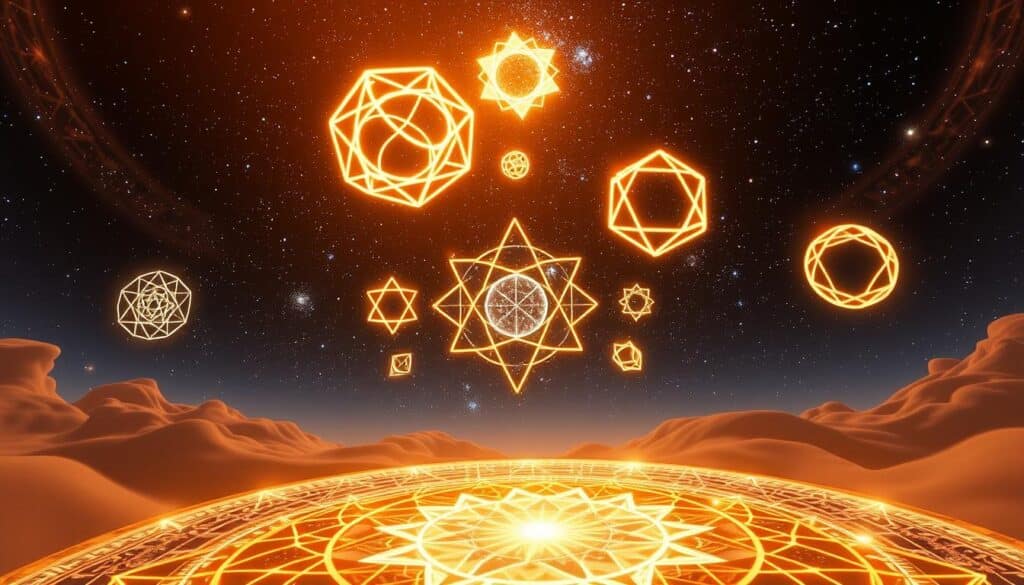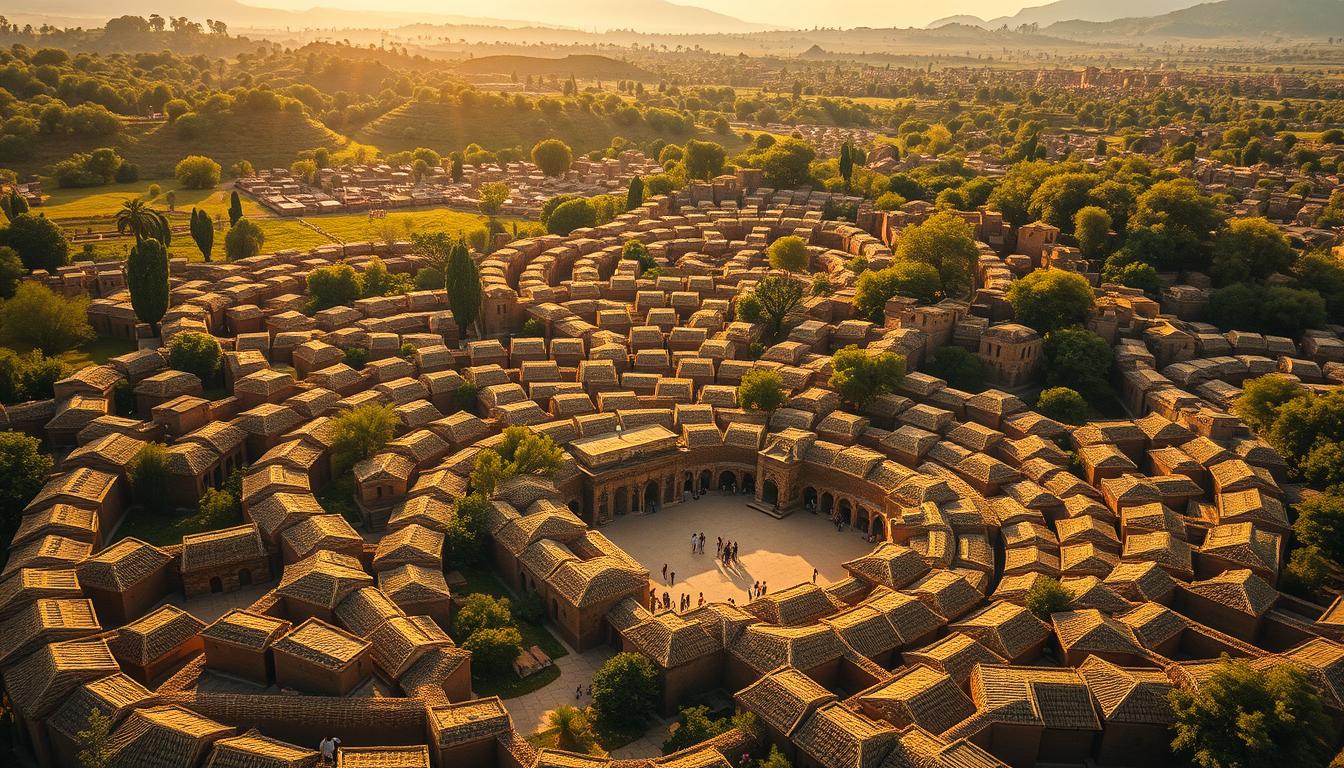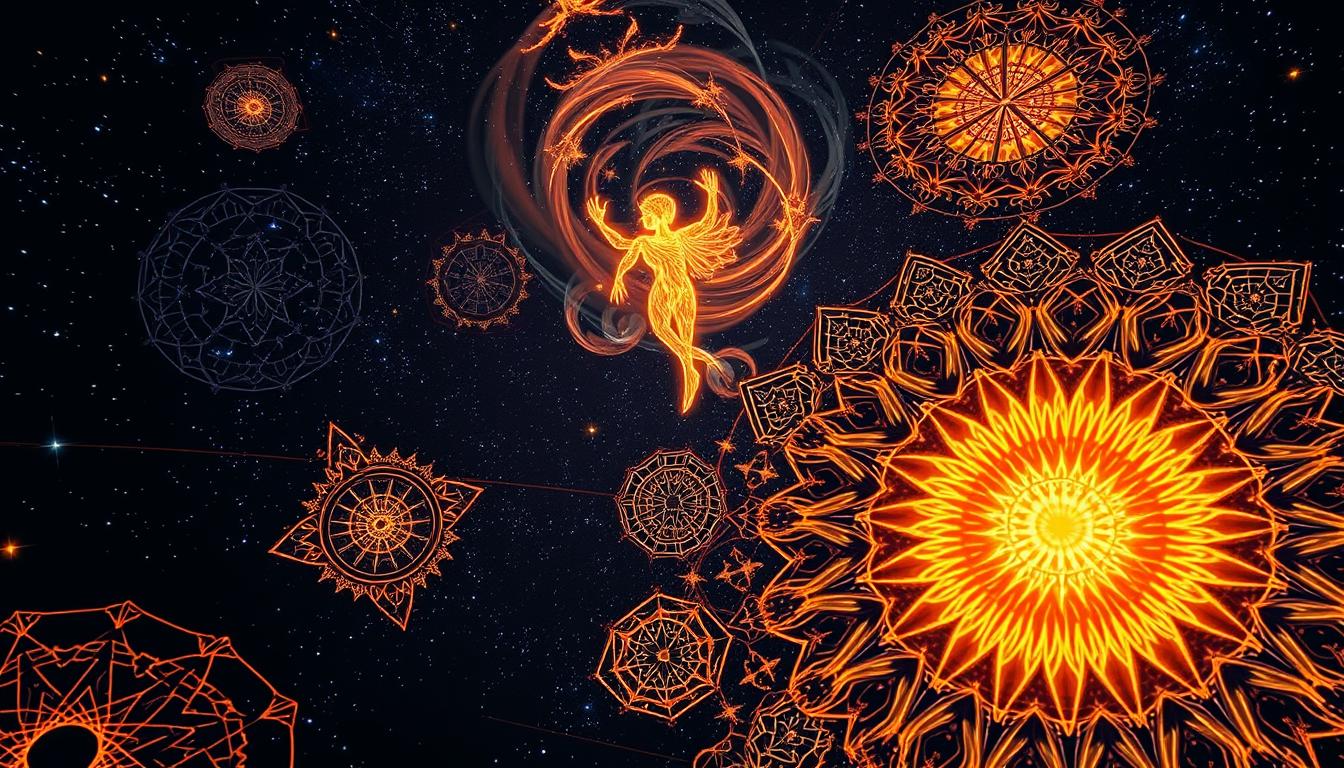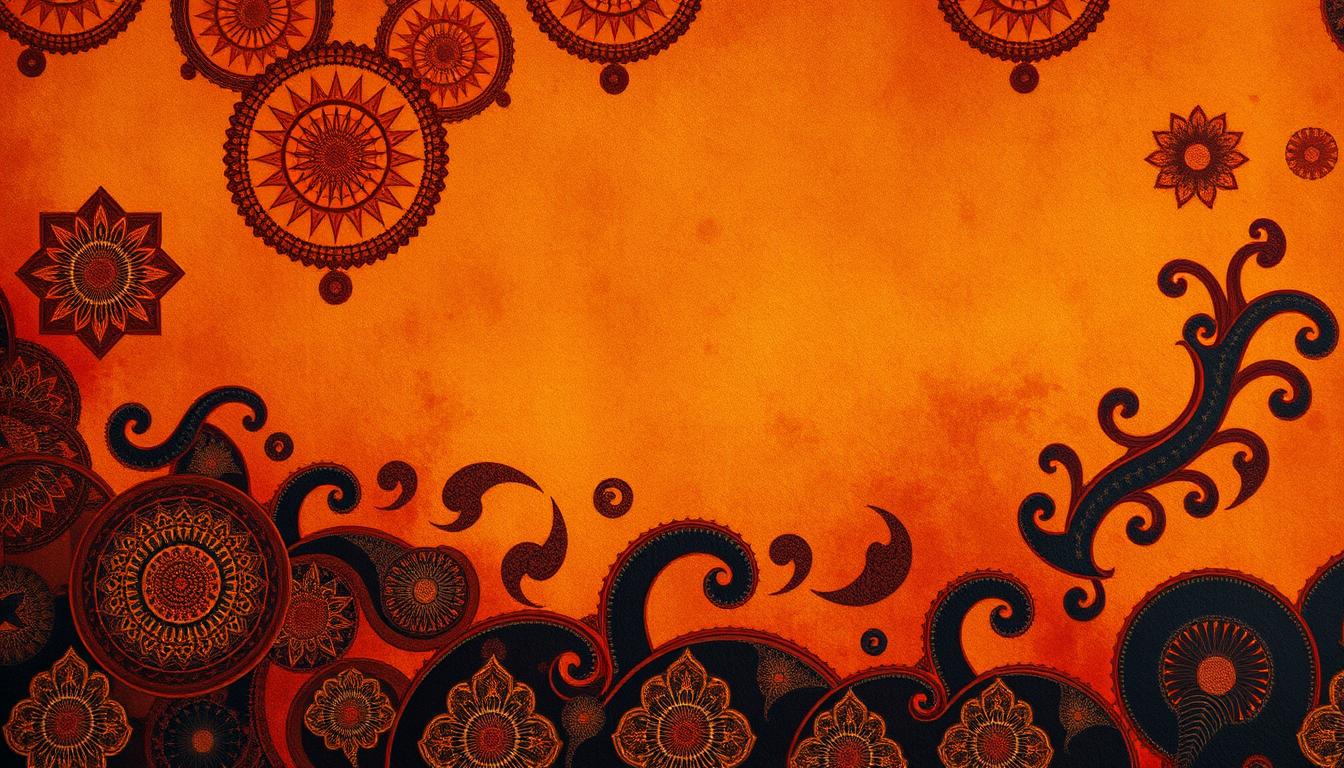Sacred geometry bridges math and spirituality, enriching our grasp of indigenous beliefs. It highlights sacred geometry’s key role in spiritual architecture and its deep ties to heritage. Through analyzing geometric patterns in rituals, symbols, and beliefs, we see how different cultures showcase their spirituality and roots.
Introduction to Sacred Geometry
Sacred geometry is more than just shapes. It is valued for its spiritual meaning. Going back to ancient times, we see how deeply humans were connected to the universe’s math. This introduction shows the role of sacred geometry throughout history, particularly in indigenous cultures. These cultures saw geometry as a key to understanding life itself.
Understanding these shapes helps us see how everything in life is connected. It leads us to see the divine in our world. Indigenous spirituality’s designs show a deep bond between art, math, and beliefs.
The meaning of geometric patterns grew as societies developed. They came to represent more than just math—they tied to creation stories and the cosmos. These shapes share a spiritual message across different traditions. They show our shared desire to know more and connect with something greater than ourselves.

The Interconnection Between Geometry and Spirituality
Geometry and spirituality share a deep connection that goes beyond simple shapes and angles. Sacred shapes in many religious and philosophical traditions represent spiritual truths. For instance, circles symbolize infinity and eternal life, showing unity. Squares, on the other hand, stand for stability and order, reflecting the grounding in spiritual practices.
Plato, a famous thinker, saw geometry as key to unlocking deeper truths. He showed how geometric forms can be a symbolic language that links the physical and spiritual realms. This connection helps people understand their beliefs and feel closer to the divine.
Geometry acts as a bridge between the seen and unseen parts of life. The way ancient and modern spiritual practices use sacred shapes shows how geometry helps us understand the universe. It reveals the special relationship between physical forms and spiritual meanings.
Indigenous Architecture and Sacred Geometry
Indigenous architecture is deeply tied to cultural roots and the Earth. Sacred designs make these buildings mirror the spirit of indigenous peoples. They use sacred geometry to make spaces that show their beliefs and values.
The Spiritual Dimensions of Design
This style isn’t just about looks. It weaves spirituality into design, showing the bond between humans and nature. Indigenous cultures craft sacred spaces with care. They align them with the stars, landscapes, and nature. This creates a feeling of connection and respect for the world.
Examples from Different Indigenous Cultures
Around the world, indigenous buildings show this spiritual link. Machu Picchu is known for its exact shapes, linking it to the cosmos. North American longhouses reflect community spirit. Inuit igloos highlight living in balance with nature, showing how to adapt and sustain.
The Role of Sacred Geometry in Rituals and Ceremonies
Sacred geometry is key in the spiritual life of indigenous peoples. These rituals show deep beliefs through shapes and patterns. For example, circles often mean unity and the circle of life. In many ceremonies, these shapes help guide participants. They build a spiritual connection.
Some rituals use specific designs to connect with spiritual energies or ancestors. By using sacred geometry, people reach deeper understanding. This strengthens not only the ceremonies but also the community’s traditions. Each shape has its own meaning passed down through generations.
Highlighting sacred geometry in these ceremonies shows its importance. It’s not just about looks. It plays a big part in enhancing the spiritual journey. This makes the ritual’s essence really hit home for those taking part.
Patterns and Symbols Used in Indigenous Spiritual Practices
Indigenous spiritual practices use geometric shapes and symbols. They tell important cultural stories through a visual language. These patterns are found in art, artifacts, and ceremonial items, showing what different cultures value and believe.
The Meaning Behind Geometric Shapes
Geometric shapes are more than just nice to look at; they carry deep spiritual meanings. Among them are:
- Triangles: Stand for balance and moving towards higher spiritual levels.
- Spirals: Symbolize growth, big changes, and life’s ongoing cycle.
- Circles: Often mean unity, wholeness, and how all life is connected.
These shapes weave into indigenous designs, linking people closely with the earth and their ancestry.
Cultural Significance of Symbolic Designs
Indigenous patterns hold important cultural symbols. Every design has a story, keeping spiritual beliefs and knowledge alive. For example:
- The Medicine Wheel: Is seen in many Native American cultures, showing life’s cycle and balance.
- Maori Carvings: Use geometric patterns to tell stories of ancestors, linking old and new.
These special designs add depth to indigenous arts and crafts. They keep ancestral wisdom alive in each generation.
Sacred Geometry as a Foundation for Indigenous Spiritual Beliefs
Sacred geometry is crucial in shaping indigenous beliefs. It lets communities express their view of the universe. It shows how all living things are connected in the cosmos.
Indigenous rituals draw heavily from these patterns. They influence both physical spaces and spiritual activities. These patterns guide lives close to nature.
This exploration of sacred geometry shows its deep impact. It’s more than pretty designs. It carries deep wisdom passed down through ages. It links every being to its environment.
The Connection with Nature in Indigenous Spirituality
Nature is very important in indigenous spirituality. It’s seen as a living part of their beliefs. For indigenous people, land is not just a setting; it’s holy and full of spirit. This deep bond is shown in how they build and perform rituals, always in tune with nature.
Their buildings reflect the land around them, using sacred geometry. This means they don’t just construct buildings; they make them to honor their environment. These structures show a respect for nature that has been passed down through the ages.
This connection shows that nature and spirituality are linked, teaching us to respect the earth. By seeing this link, we learn the value of caring for our planet, just as indigenous people have for so long.
Preserving Indigenous Knowledge and Architectural Heritage
Keeping indigenous knowledge alive is key to protecting cultural identity and architectural heritage. Traditional building methods, like adobe, use natural materials and carry deep cultural wisdom. These techniques are not just practical. They hold spiritual and cultural stories, linking communities to their past.
Importance of Traditional Techniques
Traditional building methods reflect a people’s identity and values. They show who they are and what they believe in. Using these techniques, indigenous groups express their culture and stand strong against modern changes. This keeps their communities united and strong.
Modern Efforts to Preserve and Honor Sacred Spaces
Today, there’s a big push to protect sacred indigenous places. These efforts include fixing old structures and getting legal protections for these sites. Indigenous leaders, architects, and conservationists work together. They aim to keep these spaces safe and honor their cultural importance.
Conclusion
Sacred geometry holds great value in indigenous spirituality. It reveals how different cultures view their bond with nature, their community, and ancestors. Using patterns, it connects the visible and invisible worlds, showing a deep understanding that goes beyond time and space.
It plays a key role in architecture, rituals, and symbols, keeping cultural heritage alive. By preserving these practices and sacred places, we honor indigenous peoples. Plus, we add to our shared history.
Understanding sacred geometry helps us grow closer to nature and each other. It encourages us to think about our collective heritage. Keeping sacred geometry alive lets indigenous spirituality’s richness touch future generations.



